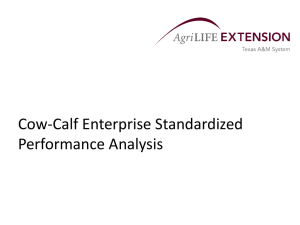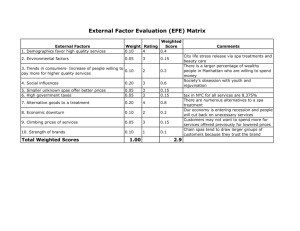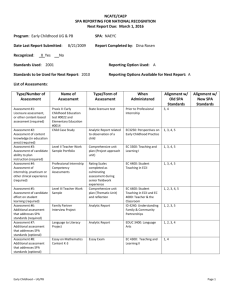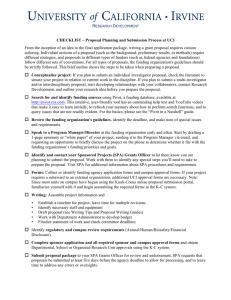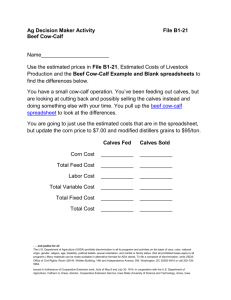Cow-Calf Enterprise Standardized Performance Analysis Risk Management Stan Bevers and Dean McCorkle*
advertisement
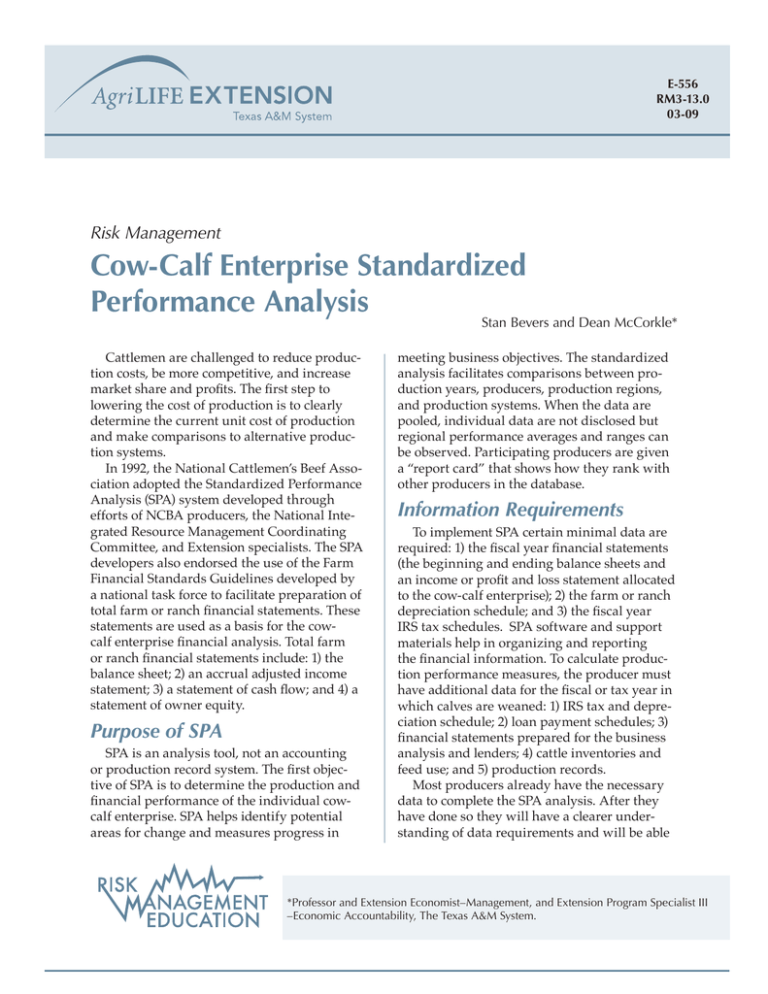
E-556 RM3-13.0 03-09 Risk Management Cow-Calf Enterprise Standardized Performance Analysis Stan Bevers and Dean McCorkle* Cattlemen are challenged to reduce production costs, be more competitive, and increase market share and profits. The first step to lowering the cost of production is to clearly determine the current unit cost of production and make comparisons to alternative production systems. In 1992, the National Cattlemen’s Beef Association adopted the Standardized Performance Analysis (SPA) system developed through efforts of NCBA producers, the National Integrated Resource Management Coordinating Committee, and Extension specialists. The SPA developers also endorsed the use of the Farm Financial Standards Guidelines developed by a national task force to facilitate preparation of total farm or ranch financial statements. These statements are used as a basis for the cowcalf enterprise financial analysis. Total farm or ranch financial statements include: 1) the balance sheet; 2) an accrual adjusted income statement; 3) a statement of cash flow; and 4) a statement of owner equity. Purpose of SPA SPA is an analysis tool, not an accounting or production record system. The first objective of SPA is to determine the production and financial performance of the individual cowcalf enterprise. SPA helps identify potential areas for change and measures progress in meeting business objectives. The standardized analysis facilitates comparisons between production years, producers, production regions, and production systems. When the data are pooled, individual data are not disclosed but regional performance averages and ranges can be observed. Participating producers are given a “report card” that shows how they rank with other producers in the database. Information Requirements To implement SPA certain minimal data are required: 1) the fiscal year financial statements (the beginning and ending balance sheets and an income or profit and loss statement allocated to the cow-calf enterprise); 2) the farm or ranch depreciation schedule; and 3) the fiscal year IRS tax schedules. SPA software and support materials help in organizing and reporting the financial information. To calculate production performance measures, the producer must have additional data for the fiscal or tax year in which calves are weaned: 1) IRS tax and depreciation schedule; 2) loan payment schedules; 3) financial statements prepared for the business analysis and lenders; 4) cattle inventories and feed use; and 5) production records. Most producers already have the necessary data to complete the SPA analysis. After they have done so they will have a clearer understanding of data requirements and will be able *Professor and Extension Economist–Management, and Extension Program Specialist III –Economic Accountability, The Texas A&M System. to improve the accuracy of the SPA analysis with better data over time. Most producers complete the cow-calf SPA analysis while participating in workshops sponsored by state Extension services. Workshop leaders advise producers about what data to assemble and how to input it. Extension faculty or trained SPA consultants also meet privately with producers to discuss their enterprises. Completing the SPA should not be a one-time activity, but should be done annually so that producers can analyze trends and see the results of changes they have made. Producers may be able to complete the SPA analysis on their own after the first experience. They can submit their data and receive the SPA report card on request. analysis. Your accountant can be of great assistance in preparing necessary financial data. This is the most important data needed for the fiscal year, normally the tax year, in which calves are weaned: •IRS tax schedules, especially Schedule F •Depreciation schedule •Loan payment schedules •Financial statements that have been prepared for the fiscal year business analysis or the lender. Anything is helpful for a starting point. Statements would include: * Beginning and ending fiscal year balance sheet (ending is next year’s beginning) * Income statement (accrual adjustments will be made for the analysis) Specific Data Needs Sources for SPA financial data •IRS tax schedules for fiscal or tax year or analysis * Schedule F – Profit or Loss from Farming * Form 4562 – Depreciation and Amortization * Form 4797 – Sales of Business Property •Depreciation schedule for operation •Loan payment schedules, available from each lender •Beginning and ending balance sheet showing all business assets and liabilities (the depreciation schedule has information for depreciable assets) Assembling necessary data is the most important step in the process. Remember that the SPA analysis is for the fiscal year in which the calves are weaned. For a spring-calving herd, cows are exposed in the preceding fiscal year (e.g., 2008 spring calves are from your cows exposed in 2007). Here is a general list of the information needed: Production Data •General ranch and land use descriptive data •The cow herd management/production season data—breeding, calving, weaning •Weaned calf production, value, and cull or breeding cattle sales •Land use, both owned and leased •Feed use and end-of-year inventory •Breeding cattle inventories •Number of breeding females exposed Good to have •End-of-year inventories for cattle and feed. If there were major differences between beginning and ending inventories of fuel, vet supplies or other high cost items, record these inventories for development of accrual adjusted income statements. •Enterprise revenue and expenses if the business accounting system generates enterprise values. Otherwise, allocation decisions can be made by the manager when doing SPA from the total financial statement. Use what you have first and then learn if there can be improvements. Specific Cattle Inventories The breeding cattle inventory: •At the end or beginning of the fiscal year •At the beginning of the breeding season •When cows are pregnancy tested, record bred, and open Financial Data Assemble existing financial data, then have the experienced SPA user help prepare it for the SPA 2 Cow SPA Performance Measures enterprise financial and economic evaluation. The following measures and their associated computational procedures, interpretation and identified limitations are based on accurate total farm and ranch financial statements and a complete cattle inventory. Enterprise financial data is developed from the operation’s financial statements and/or direct enterprise records that are consistent with the operation’s financial statements. Financial statements are for both the total operation and the cow-calf enterprise. These performance measures have been chosen. Reproduction •Based on exposed females * Pregnancy percentage2 * Pregnancy loss percentage2 * Calving percentage * Calf death loss1 * Calf crop or weaning percentage1 * Female replacement rate2 •Calf death loss based on calves born1 •Calving distribution2 •Cumulative distribution - Calves during first 21 days - Calves during first 42 days - Calves during first 63 days - Calves after first 63 days Marketing information •Marketing method •Pricing method •Dominant breed •Pay weight cattle prices ($/cwt) * Calves * Culls * Steers/bulls, cows * Heifers, bulls * Weighted average Production •Based on exposed females * Average calf weaned age (months) * Actual weaning weight (pounds per head)1 - Steers/bulls - Heifers - Average weaning weight * Pounds weaned per exposed female1 Financial expenses vs. economic costs The financial and economic summary is calculated per breeding cow and per hundred-weight of calf weaned. It is important to have a clear understanding of the difference between financial and economic costs, as it is used in the development of these measures. The financial enterprise analysis is taken directly from the income statement. Expenses are those typically found in an accounting income statement, although some additional items may be required for the enterprise analysis. Expenses include cash operating expenses, interest for operating capital, term debt and non-cash expenses. The financial analysis does not account for the economic opportunity cost of land, raised feed or equity capital invested in the enterprise. Actual land mortgage, livestock, machinery and operating capital interest expense are included in the financing expense. The economic analysis accounts for the opportunity cost of resources used in production of the commodity, in addition to expenses in the financial analysis. Land opportunity cost, for example, is the estimated rental rate that would be paid for Grazing and raised feed land measures •Acres per exposed female1 * Grazing acres per exposed female * Raised feed acres per exposed female * Crop aftermath acres per exposed female •Pounds weaned per acres used by the cowcalf enterprise1 •Dominant grazing method—exposed females2 •Pounds of raised/purchased feed fed per breeding cow2 Marketing and financial performance measures In no area of performance evaluation is there a greater need for standardization of terminology and calculation procedures than in the cow-calf 3 land under an equivalent production system. Opportunity cost of capital is the rate of return that one could expect to earn on that capital in an alternative investment with similar risks. Details are identified with each measure to help explain the difference between the financial and economic analysis. Financial position3 •Investment per breeding cow (value of assets) * Current assets * Livestock * Machinery and equipment * Other non-current assets * Real estate—land and improvements * Total investment •Debt per breeding cow (enterprise liabilities) •Equity to assets or percent equity Financial and economic performance per breeding cow and per cwt of calf weaned •Total raised/purchased feed cost •Total grazing cost •Gross cow-calf enterprise accrual revenue •Total cow-calf enterprise operating cost4 •Total financing cost and economic return •Total cost before non-calf revenue adjustment •Net income5 •Percent return on enterprise assets (ROA) •Unit cost of production (economic breakeven price) * Total non-calf revenue * Total calf cost (non-calf revenue adjusted) •Rate of economic return on the owned real estate investment Primary performance measures that must be supplied by the participant. 2 Secondary performance measures that the participant may not be able to provide. 3 Based on cost and market valuation of assets. 4 These are pre-tax costs and do not include income tax payments. Withdrawals are included in the cost calculation. 5 The net income is pre-tax income but is not equal to IRS taxable income. 1 IRM-SPA Educational Materials and Software The Texas AgriLifeExtension Service has prepared software and worksheets to help producers implement SPA. These tools help organize production and financial data into a focused, well-defined performance analysis of the total farm or ranch and the cow-calf enterprise. Additional information, including summary results for Texas cow-calf producers, is available on the Internet at http://agrisk.tamu.edu. Texas producers who desire more information should contact Stan Bevers at (940) 552-9941 ext. 231. Partial funding support has been provided by the Texas Corn Producers, Texas Farm Bureau, and Cotton Inc.–Texas State Support Committee. Produced by AgriLife Communications, The Texas A&M System Extension publications can be found on the Web at: http://AgriLifeBookstore.org. Visit Texas AgriLife Extension Service at http://AgriLifeExtension.tamu.edu. Educational programs of the Texas AgriLife Extension Service are open to all people without regard to race, color, sex, disability, religion, age, or national origin. Issued in furtherance of Cooperative Extension Work in Agriculture and Home Economics, Acts of Congress of May 8, 1914, as amended, and June 30, 1914, in cooperation with the United States Department of Agriculture. Edward G. Smith, Director, Texas AgriLife Extension Service, The Texas A&M System.
